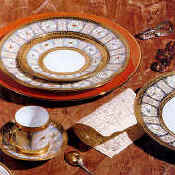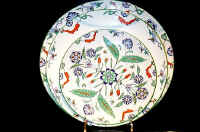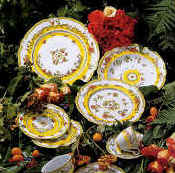Limoges Porcelain
Explore the Limoges porcelain creative process from ingredients, to casting, to firing, and finally decoration
Introduction
Limoges porcelain manufacture is extremely complex and demands
meticulous workmanship. Limoges porcelain is a result of a mix of
various components delicately measured and successively fired at a very
high temperature. A piece of Limoges porcelain often requires up to 30
processes starting with the extraction of the raw material to the
final stage of decoration. The cornerstone of Limoges Porcelain lies in
the combination of advanced modern techniques, high quality
materials and superb craftsmanship.
 An
example of the magnificent end product
An
example of the magnificent end product
Ingredients of Limoges Porcelain
Kaolin clay - Gives the whitening and plastic quality.
Quartz - Allows the solidity of the piece.
Feldspath - Gives the porcelain it's translucence.
Casting
Casting is the creation of the shape. The process begins by pouring the
mixed liquid into deep molds that have been formed to produce a
particular design. When the liquid becomes solid the excess is
discarded. The layer shaped around the contours of the mold is the piece
itself.
The piece is then hand cleaned of to eliminate imperfections. Then
additions are made to the original form by the way handles or other
objects that can be attached to the piece. The additional
objects are glued into place and then the whole piece is fired at 980
degrees C in order to dehydrate the porcelain. After the cooling, the
piece becomes porous and it is cleaned and prepared for enameling.
 An
example of the magnificent end product
An
example of the magnificent end product
Firing
This operation is carried out by spraying or immersing of the pieces of
liquid enamel followed by "high fire" that brings the
material to a melting point of 1400 degrees C. The porcelain is then
glazed and undergoes a reduction of volume of about 12%. When it comes
out of the kiln, the pieces have differences and slight irregularities
that are inevitable yet illustrate the authenticity of individually
crafted Limoges porcelain. No two pieces of Limoges porcelain are ever identical. At this
point, the porcelain can be sold as "white
porcelain" or enter the next process called decoration..
The Limoges Porcelain Decoration Process
There are many different processes of decoration. Each requires top
quality craftsmen using experience gathered over many years. In all cases, the process is to apply
glazed colors and sometimes precious metals to the porcelain. Once fired
at the different temperature, they will adhere perfectly to the enamel
of the porcelain.
The most commonly used method is the transfer by chromolithography. It
is achieved by the application on the porcelain of a special sheet that is
placed in the desired area, on the pieces to be decorated. The sheets
are initially created by offsetting printing or serigraphy. Sometimes
the pieces that are decorated this way are complemented with a simple
design using a brush.
The most desirable and the most expensive method, is the
hand made design. It is the creation, by ink-pin, and/or the brush
designs that are more complex, and often recreated from old models or born
from the designers imagination.
 An
example of the magnificent end product
An
example of the magnificent end product
All the above Robert Haviland and C. Parlon Limoges Porcelain can be viewed and purchased at:-